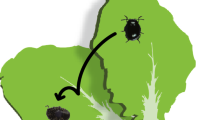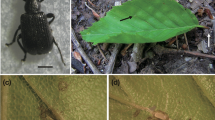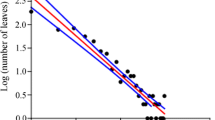Abstract
The attelabid beetle Cycnotrachelus roelofsi constructs two types of leaf-rolls (cradles): one is suspended from leaves (suspended type), and the other is severed from the leaves (cut-off type). To evaluate differences in performance between these two cradle types, we monitored densities, survival rates, and mortality factors throughout the active season, from April to June. The proportions of the two cradle types changed over time; the suspended type was dominant early in the season but was gradually replaced by the cut-off type. Irrespective of differences in mortality factors between the two cradle types, the survival rate was always higher in the cut-off type than in the suspended type. Beetle mortality tended to be highest at the egg stage, and the predominant cause of mortality was parasitism by two minute trichogrammatid wasp species, Poropoea morimotoi and P. sp.1. Parasitism by P. morimotoi was significantly higher in cut-off cradles than in suspended cradles, when cut-off cradles were abundant, whereas parasitism by P. sp.1 tended to be higher in suspended cradles when suspended cradles were abundant. These results suggest opposed frequency-dependent attacks by P. morimotoi and P. sp.1. We discuss how these egg parasitoids maintain coexistence of these two cradle types.







Similar content being viewed by others
References
Beschovski VL, Georgiev GT (1993) Three species of Diptera–Acalyrtrata (Diptera) dwelling galls of Paranthrene tabaniformis Rott. (Lepidoptera, Aegeriidae). Acta Zool Bulgarica 46:44–49
Daanje A (1957) Die blattrolltechnik von Apoderus coryli L. und Attelabus nitens Scop. (Coleoptera, Attelabidae). Behaviour 11:85–155
Daanje A (1964) Über die Ethologie und Blattrolltechnik von Deporaus betulae L. und ein Vergleich mit den anderen Blattrollenden Rhynchitinen und Attelabinen (Coleoptera, Attelabinae). Noord-Hollandsche Uitgevers Maatschppij, Amsterdam
Godin J-GJ (1995) Predation risk and alternative mating tactics in male Trinidadian guppies (Poecilia reticulata). Oecologia 103:224–229
Gønget H (2003) The Nemonychidae, Anthribidae and Attelabidae (Coleoptera) of Northern Europe. Fauna Entomologica Scandinavica 38. Brill, Leiden
Gross MR (1996) Alternative reproductive strategies and tactics: diversity within sexes. Trend Ecol Evol 11:92–98
Hirose Y (1963) Discovery of the genus Poropoea parasitic on the eggs of attelabid beetles in Japan (Hymenoptera, Trichogrammatidae). Acta Hymenopterologica 2:29–35
Hirose Y (1968) Egg parasitism of some leaf-rolling weevils in relation to the number of eggs laid in a leaf roll, with special reference to a parasitism by Poropoea morimotoi Hirose (Hymenoptera: Trichogrammatidae) (in Japanese). Kontyu 36:377–388
Howden AT, Gill BD (1992) A ball-rolling neotropical weevil, Pilolabus viridans (Gyllenhal) (Coleoptera: Attelabidae). Am Entomol 38:40–44
Hunt J, Simmons LW (2001) Status-dependent selection in the dimorphic beetle Onthophagus taurus. Proc R Soc London B 268:2409–2414
Iwata K (1935) On the habits of some Rhynchitinae, Attelabinae and Apoderinae in Japan (in Japanese). Kontyu 9:261–278
Iwata K (1944) My history of the study of leaf-rolling weevils. In: The notes of a naturalist (in Japanese). AsahiShinbunsha, Tokyo, pp 14–24
Murata G (1993) Styracaceae. In: Satake Y, Hara M, Watari S, Tominari T (eds) Wild flowers of Japan: trees (in Japanese). Heibonsha, Tokyo, pp 143–144
Radwan J (1995) Male morph determination in two species of acarid mites. Heredity 74:669–673
Sakurai K (1983) Ethological and ecological studies of leaf-roll weevils and other small animals. In: Hidaka T (ed) Ethological research of small animals in the humid tropics. Department of Zoology, Kyoto University, Kyoto, pp 129–146
Sakurai K (1986) Multiple oviposition by Apoderus balteatus (Coleoptera, Attelabidae) is associated with larger leaves. Ecol Entomol 11:319–323
Sakurai K (1988) Leaf size recognition and evaluation of some attelabid weevils (2) Apoderus balteatus. Behaviour 106:301–317
Suzuki K (1999) The laterality, or a variety of phenomenon—laterality in insects (in Japanese). Iden 53:13–20
Suzuki K, Uehara C (1997) Cradle structure and formation process in the subfamilies Apoderinae and Attelabinae (Coleoptera, Attelabidae) from Japan (in Japanese). Bull Hoshizaki Green Found 1:99–204
Tokuda M, Maryana N, Yukawa J (2001) Leaf-rolling site preference by Cycnotrachelus roelofsi (Coleoptera: Attelabidae). Entomol Sci 4:229–237
Acknowledgments
We thank K. Kanmiya for identifying chrolopid flies, T. Hirowatari and I. Ohshima for identifying moths, and K. Suzuki for helpful comments.
Author information
Authors and Affiliations
Corresponding author
Rights and permissions
About this article
Cite this article
Kobayashi, C., Kato, M. To be suspended or to be cut off? Differences in the performance of two types of leaf-rolls constructed by the attelabid beetle Cycnotrachelus roelofsi . Popul Ecol 46, 193–202 (2004). https://doi.org/10.1007/s10144-004-0179-7
Received:
Accepted:
Published:
Issue Date:
DOI: https://doi.org/10.1007/s10144-004-0179-7




